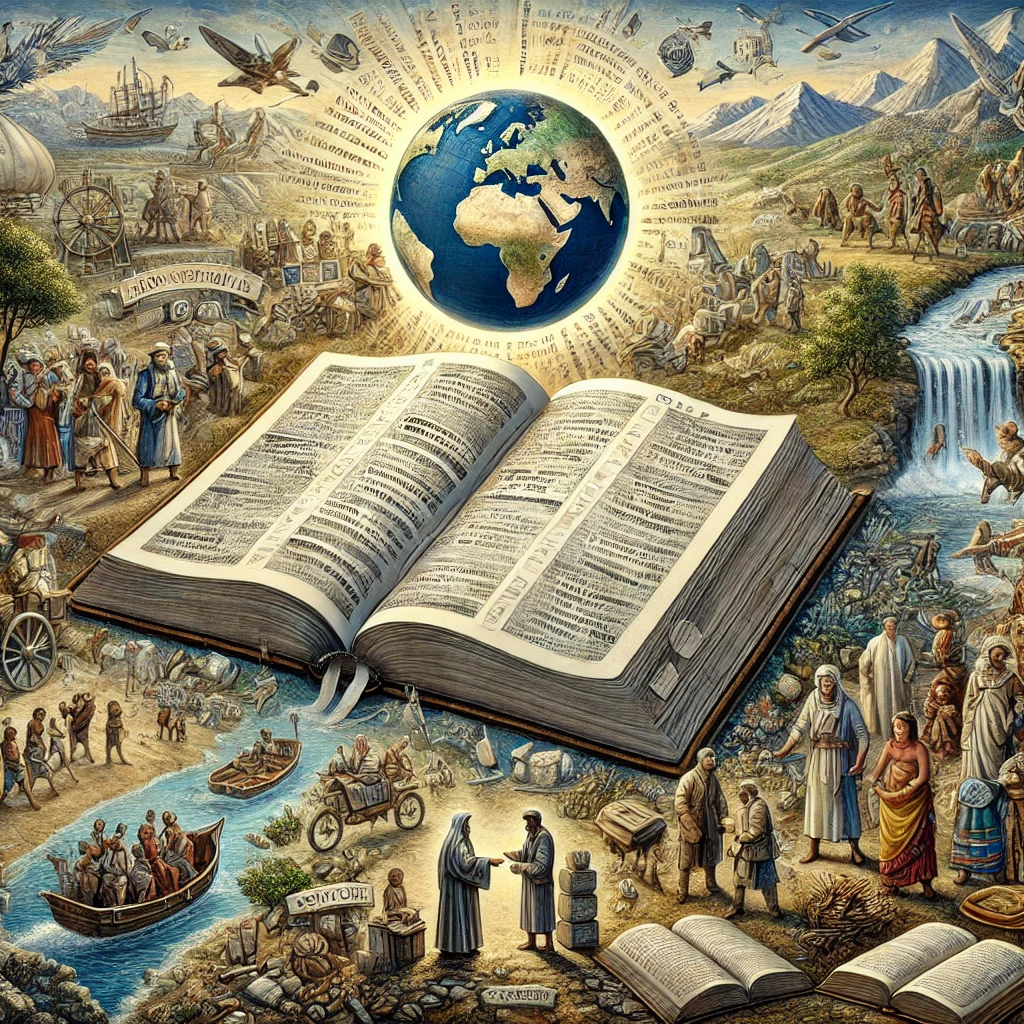引言:信仰的挑战与传道者的使命
《圣经》是世界上被翻译最多的书籍之一,已经被翻译成超过3400种语言。然而,在这光辉的背后,隐藏着无数传道者的艰辛付出和坚定不移的信仰。在中国以及全世界,传道者们面对着巨大的挑战,克服了语言障碍、文化差异、社会动荡和政治压迫,将神的话语带给渴望真理的民众。然而,今天的许多基督徒在面对生活中的挑战时,信仰变得动摇,悔改之心不再坚定。通过回顾《圣经》在中国及全球的翻译和传播简史,我们可以从中汲取力量,重新点燃信仰的火焰。
第一部分:全球《圣经》翻译的艰辛历程
从世界范围来看,《圣经》的翻译历史充满了无数感人至深的故事,这些故事见证了信仰的力量和传道者们的不懈努力。
1、威克里夫与丁道尔的勇气
在14世纪,英国的约翰·威克里夫(John Wycliffe)发起了将《圣经》翻译成英语的运动,虽然他的翻译工作最终遭到教会的强烈反对,但他被誉为“宗教改革的晨星”。他的工作为后来者铺平了道路。16世纪,威廉·丁道尔(William Tyndale)完成了第一部现代英语《圣经》的翻译。他为了使普通百姓能够读懂《圣经》,躲避教会和政府的追捕,最终在比利时被捕并殉道。丁道尔的努力让《圣经》走入千家万户,他的翻译成为后世英格兰宗教改革的重要基石。
2、卢瑟福的非洲宣教
在19世纪,苏格兰传教士罗伯特·莫法特(Robert Moffat)深入非洲内陆,将《圣经》翻译成塞茨瓦纳语。为了学习当地的语言和文化,他花费了多年时间与当地部落共同生活。他的工作使《圣经》在非洲大陆扎下了根,影响了无数人的信仰。传道者们在恶劣的环境中忍受疾病和孤独,用他们的生命写下了信仰的见证。
3、印地语《圣经》翻译的历程
在印度,威廉·凯里(William Carey)被誉为“现代宣教之父”。他不仅将《圣经》翻译成印地语,还翻译成了孟加拉语、梵语等多种印度语言。在一个宗教和文化多样化的社会中,凯里的工作让印度数百万人能够读到神的话语。他的努力不仅改变了印度的宗教版图,也影响了整个亚洲的基督教传播。
这些传道者们在不同的地域和文化中,为了将《圣经》翻译成当地语言,付出了巨大的努力和牺牲。他们不仅克服了语言和文化的障碍,还面对着来自宗教、政治和社会的多重压力。正是他们的努力,才使得《圣经》成为全球最广泛传播的书籍之一。
第二部分:《圣经》在中国的翻译与传播:百年艰辛路
中国的《圣经》翻译工作可以追溯到明朝末年,但真正的广泛传播则是在19世纪。19世纪初,西方传教士开始陆续进入中国,带来了《圣经》和福音。然而,语言的障碍、文化的差异以及社会的动荡,使得《圣经》翻译成为一项艰巨的任务。
1807年,英国传教士马礼逊(Robert Morrison)抵达中国,开始了他漫长而艰苦的《圣经》翻译工作。经过十余年的努力,他终于在1819年完成了中文《圣经》的翻译。这是第一部完整的中文《圣经》,为中国的基督教传播奠定了基础。然而,马礼逊和他的同工们面临的不仅是语言的挑战,还有来自清政府的压力和社会的排斥。他们在隐秘中工作,冒着生命危险传递福音。
20世纪初,中国社会经历了巨大的动荡,从辛亥革命到抗日战争,再到新中国的成立,基督教在中国的发展几经波折。《圣经》的翻译和传播工作一度受到严厉的打压,但传道者们并没有因此放弃。1949年之后,尽管环境愈发严峻,《圣经》的翻译工作依然在坚持进行,许多传教士和本地信徒为此付出了极大的牺牲。
改革开放后,随着宗教政策的松动,《圣经》得以重新进入公众视野。然而,面对现代社会的快速变迁,传道者们又一次面临新的挑战:如何在一个日益世俗化和多元化的社会中,保持信仰的纯洁和力量。
第三部分:现代基督徒的信仰挑战与反思
现代中国基督徒面临的挑战,与百年前传道者的艰辛有着不同的表现形式。如今,《圣经》已被翻译成普通话、粤语、客家话以及各类少数民族语言,基督徒可以轻松地获取《圣经》并参加宗教活动。然而,物质生活的丰富、社会的多样性以及信仰的自由,反而让许多基督徒逐渐失去了信仰的热忱和对悔改的迫切感。
许多基督徒在繁忙的工作和日常生活中,渐渐忽视了灵性成长的重要性。他们的信仰变得形式化、表面化,缺乏内在的力量。面对困境时,他们往往选择逃避或妥协,而不是坚定信仰,依靠神的力量去克服困难。这种信仰的冷淡和妥协,正是现代基督徒所需要反思和悔改的。
第四部分:从《圣经》翻译史中汲取力量
《圣经》在全球及中国的传播历史,是一部充满挑战与胜利的历史。每一次翻译,每一段传播,都是传道者们用血汗和信仰写就的篇章。他们坚信,神的话语具有穿透一切阻碍、带来生命更新的力量。正是这种坚定不移的信仰,使得《圣经》能够在世界各地生根发芽,影响无数人的生命。
今天,我们生活在一个相对和平与繁荣的时代,但这并不意味着我们可以放松对信仰的追求。相反,我们应当从那些传道者的故事中汲取力量,反思自己在信仰生活中的不足,重新点燃对神的爱和对真理的渴求。
结语:重新点燃信仰的火焰
《圣经》被翻译成数千种语言,这是信仰在全球范围内传播的见证。每一位基督徒都应当铭记这些历史,从中汲取力量,反思自己的信仰生活。无论外界环境如何变化,我们都要坚守对神仰望和交托,依靠祂面对生活中的挑战。
圣经都是 神所默示的,于教训、督责、使人归正、教导人学义都是有益的,(提摩太后书 3:16 和合本)也就是说,每个人生活中遇到的问题:你对过往的依赖、对未来的担忧、对生活和患难的面对等等都有神的作为在其中做工,我们需要将圣经中神的话语化作我们与祂交托的媒介,并融合在日常的行为当中。
一生中我们会遇到很多问题和境况,靠自己的血肉之躯终究乏力,唯有将我们的‘司令部’~~~头脑的指挥权交给神,按照祂给我们预备的路去走才是最顺畅的。

让我们一起为此祷告!
(如有建议敬请留言讨论,邮箱:[email protected])
The Torch of Faith: Drawing Strength from the Global History of Bible Translation
Introduction: The Challenge of Faith and the Mission of the PreacherThe Bible is one of the most translated books in the world—rendered into over 3,400 languages. Yet behind this radiant achievement lie the hardships and unwavering faith of countless evangelists. In China and around the globe, preachers have faced tremendous challenges. They have overcome language barriers, cultural differences, social upheaval, and political oppression to bring God’s Word to people hungry for truth. However, many Christians today, when facing life’s challenges, find their faith wavering and their hearts no longer resolutely repentant. By reviewing the brief history of the Bible’s translation and dissemination both in China and worldwide, we can draw strength and rekindle the flame of our faith.
Part One: The Arduous Journey of Bible Translation Around the World
Across the globe, the history of Bible translation is filled with deeply moving stories that testify both to the power of faith and to the tireless efforts of the preachers.
- The Courage of Wycliffe and Tyndale
In the 14th century, John Wycliffe of England initiated the movement to translate the Bible into English. Although his work eventually met fierce opposition from the Church, he is hailed as the “Morning Star of the Reformation” and paved the way for future efforts. In the 16th century, William Tyndale completed the first modern English translation of the Bible. To enable ordinary people to read Scripture, he evaded both Church and state persecution, ultimately being captured and martyred in Belgium. Tyndale’s efforts brought the Bible into countless homes and became an essential foundation for the English Reformation.
- Rutherford’s African Mission
In the 19th century, Scottish missionary Robert Moffat ventured deep into the African interior to translate the Bible into Setswana. He spent many years living with local tribes to learn the language and culture. His work enabled the Bible to take root in Africa and influenced the faith of countless people. In harsh environments, these preachers bore illness and loneliness, writing powerful testimonies with their very lives.
- The Translation of the Bible into Hindi
In India, William Carey is revered as the “father of modern missions.” Not only did he translate the Bible into Hindi, but he also rendered it into Bengali, Sanskrit, and several other Indian languages. In a society marked by religious and cultural diversity, Carey’s work enabled millions in India to read God’s Word. His labors not only reshaped the religious landscape of India but also influenced the spread of Christianity throughout Asia.
These preachers, in various regions and cultural settings, sacrificed greatly to translate the Bible into the local languages. They not only overcame linguistic and cultural barriers but also faced multiple pressures from religious, political, and social forces. It is through their perseverance that the Bible has become one of the most widely disseminated books in the world.
Part Two: The Translation and Dissemination of the Bible in China—A Century of Struggle
The translation of the Bible into Chinese dates back to the late Ming Dynasty, but its widespread dissemination began in the 19th century. At the beginning of the 19th century, Western missionaries started entering China and brought the Bible and the gospel with them. However, the challenges of language, cultural differences, and social turmoil made Bible translation a formidable task.
In 1807, British missionary Robert Morrison arrived in China and embarked on his long and arduous journey of translating the Bible. After more than a decade of effort, he finally completed the first complete Chinese translation of the Bible in 1819. This translation laid the foundation for the spread of Christianity in China. Yet, Morrison and his colleagues faced not only linguistic challenges but also pressure from the Qing government and societal rejection. They worked in secrecy, risking their lives to spread the gospel.
In the early 20th century, Chinese society underwent enormous upheavals—from the Xinhai Revolution to the Anti-Japanese War and the establishment of the New China—during which Christianity in China experienced repeated twists and turns. Bible translation and dissemination were once severely suppressed, yet the preachers did not give up. Even after 1949, despite increasingly harsh conditions, Bible translation work persisted with many missionaries and local believers sacrificing greatly.
After the Reform and Opening Up, with a relaxation of religious policies, the Bible once again emerged into public view. However, amid the rapid changes of modern society, preachers now face new challenges: How can they maintain the purity and power of their faith in an increasingly secular and pluralistic society?
Part Three: The Spiritual Challenges and Reflections of Modern Chinese ChristiansThe challenges that Chinese Christians face today are different from the hardships of the early evangelists. Nowadays, the Bible has been translated into Mandarin, Cantonese, Hakka, and various minority languages. Christians can easily access Scripture and participate in religious activities. Yet the abundance of material comforts, societal diversity, and the freedom of belief has led many Christians to gradually lose their zeal for faith and the urgent need for repentance.
In the bustle of work and daily life, many Christians neglect the importance of spiritual growth. Their faith becomes formal and superficial, lacking inner strength. When confronted with difficulties, many choose to evade or compromise rather than stand firm in faith and rely on God’s power to overcome challenges. This cooling and compromising of one’s faith is precisely what modern Christians must reflect upon and repent.
Part Four: Drawing Strength from the History of Bible Translation
The history of the Bible’s translation and dissemination in both China and around the world is a chronicle filled with challenges and triumphs. Every translation and every act of transmission is a chapter written in blood, sweat, and faith by preachers who believed that God’s Word possesses the power to overcome every barrier and bring renewal to life. It is this unwavering faith that has allowed the Bible to take root and bear fruit across the globe, influencing countless lives.
Today, although we live in relatively peaceful and prosperous times, we must not relax our pursuit of faith. On the contrary, we should draw strength from the stories of these evangelists, reflect on our own shortcomings in our spiritual lives, and rekindle our love for God and our yearning for truth.
Conclusion: Rekindling the Flame of Faith
The Bible, having been translated into thousands of languages, stands as a testament to the global spread of faith. Every Christian should remember this history and draw strength from it, reflecting on their own spiritual journey. Regardless of how external circumstances may change, we must remain steadfast in our trust and reliance on God as we face life’s challenges. Scripture—the very Word of God—provides instruction, correction, and guidance for righteousness (2 Timothy 3:16), reminding us that every problem we encounter—whether our dependence on the past, worries about the future, or hardships in life—is within God’s sovereign working. We need to transform God’s Word into a medium through which we entrust our lives to Him and integrate it into our daily actions.
Throughout our lives, we will encounter many challenges. Our own flesh and blood will eventually fail us. Only by handing over the “command center” of our minds to God and walking the path He has prepared for us can we proceed smoothly.

This painting symbolically depicts the history of the Bible’s translation around the world and the stories of the preachers. It reflects their spirit of dedication in diverse cultures and adverse environments. The image shows the Bible being translated into many languages and preachers traversing varied terrains while facing multiple challenges—an artistic reflection of the enduring power of faith and its long-lasting impact.
Let us pray together for this!
